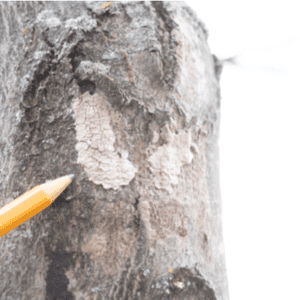Beware The Spotted Lanternfly
As we take steps to prepare our yard for spring and protect our plants from pests and disease, we should all be considerate of the fact that there is a new threat out there. This new threat comes from an insect called the spotted lanternfly. The spotted lanternfly was first discovered in the U.S. in 2014 right here in Pennsylvania and has since spread to 26 counties.
What Does a Lanternfly Look Like?

The spotted lanternfly is an invasive insect native to China that feeds on the sap of grapevines, apple trees, pines, and other species. It’s not a fly or a moth at all but a planthopper that moves from plant to plant. It is about one inch long and a half-inch wide. Its front wings are grey with black spots while its back wings are red and black with black spots. Its head and legs are black, and it has a yellow abdomen with black bands across it.
What Kind of Damage Can Lanternflies Cause?
Lanternflies move in swarms like hungry locusts. When they move, they swarm the air, and it makes being outside unbearable. They can cover a tree from top to bottom and cause considerable damage to not only trees but over 70 different plants, including oak trees, hops, apples, and peaches.
Both adult and nymph lanternflies can cause damage to plants when they feed by sucking sap from stems and leaves with their mouthparts. This can affect photosynthesis and cause the plant to decline or even die. That’s not all. As the spotted lanternfly feeds, it excretes a waste called honeydew. Honeydew is a sugary substance that is attractive to wasps, ants, and other insects. It can also be a host to sooty mold, which is harmless but can cause the tree to look dirty and unhealthy. If not controlled, the spotted lanternfly could cost the agricultural business in Pennsylvania billions of dollars in lost revenue.
How To Control The Spotted Lanternfly?

Adult lanternflies lay their eggs in the fall in mud coverings, which can contain anywhere from 30-50 eggs. The eggs are laid on surfaces such as rocks, trees, sides of houses, and decks.
From early fall to late spring, be on the lookout for these egg casings. You can scrape off the eggs with a knife and place them directly into alcohol to kill them. The nymphs are active from April through early November. Using a sticky band around the tree can help control spotted lanternflies as they climb up the tree to feed. These traps should be replaced every one or two weeks.
Spotted lanternflies are attracted to the tree of heaven, a native Chinese species that they feed on before laying eggs. These high-risk trees should be removed or thinned out to protect other plants and prevent the insects from spreading. To ensure these bugs don’t come back, keep a few of these trees around to use as bait by spraying them for insecticides.
Remember to report all lanternfly sightings to the Pennsylvania Department of Agriculture at (1-888-422-3359.)
Call The Pest Specialists At Showcase Lawn Works
To protect your yard from damaging and annoying pests, the pros at Showcase Lawn Works have what you need. From dormant oil sprays to perimeter pest control, we have the skills and the experience to keep you and your yard safe from bugs.
If you want to ensure your Pennsylvania lawn has the best spring possible, then it’s time to invest in our custom lawn care program to ensure your grass gets the care it needs.
Give us a call at 800-503-3426 or contact us here for more information. Keep up with our helpful monthly blog for more tips and tricks from the industry experts.